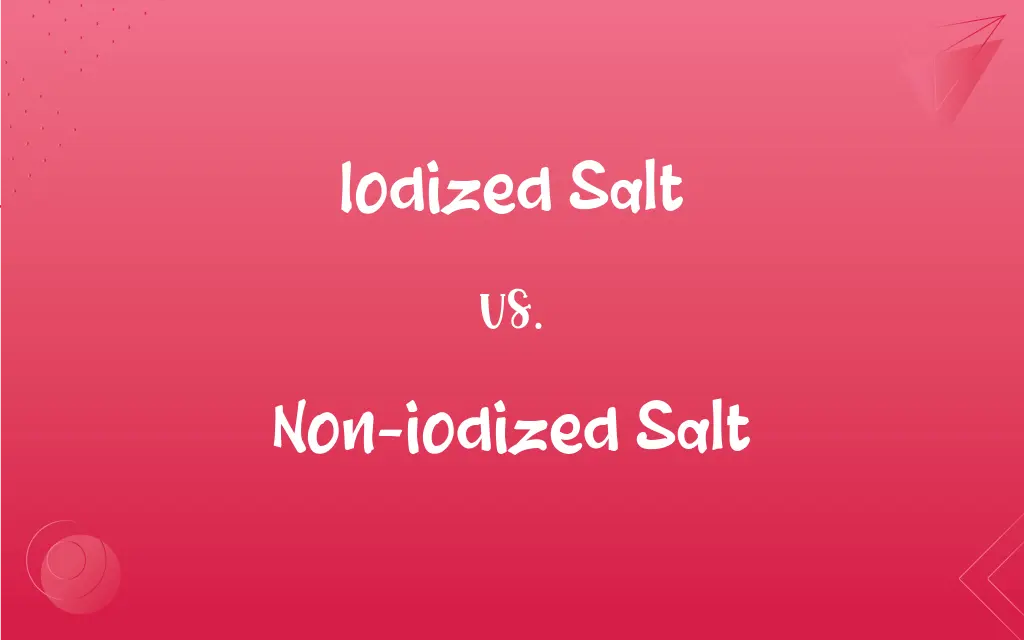Iodized Salt vs. Non-iodized Salt: What's the Difference?
Edited by Janet White || By Harlon Moss || Updated on October 7, 2023
Iodized salt contains iodine, an essential nutrient preventing thyroid issues, while non-iodized salt lacks it, offering pure saltiness without the added nutrient.

Key Differences
Iodized salt notably contains iodine, a crucial nutrient that supports thyroid function and regulates metabolism. Non-iodized salt, on the other hand, is simply salt that does not have iodine added to it. Both serve the basic culinary purpose of enhancing the flavor of food, yet the presence or absence of iodine is what distinctly sets them apart.
In the context of health implications, iodized salt has been a significant player in preventing iodine deficiency disorders. Contrarily, non-iodized salt, while it provides the basic flavor-enhancing properties of salt, does not contribute to iodine intake, making it less impactful in addressing iodine deficiency. The iodine in iodized salt is often derived from potassium iodate, ensuring that it contributes to daily iodine nutritional requirements.
From a culinary standpoint, iodized salt and non-iodized salt can often be used interchangeably in recipes. However, certain culinary applications prefer the use of non-iodized salt due to its pure, unaltered flavor, free from the slight, additional taste that iodine can impart. This implies that, depending on the culinary application, one might be chosen over the other for flavor reasons.
While both iodized and non-iodized salt can derive from various sources, such as sea or rock salt, the primary differentiation remains in the addition of iodine. Many countries endorse the use of iodized salt as a public health measure, ensuring that populations receive adequate iodine. On the flip side, non-iodized salt is often chosen for certain culinary or manufacturing applications to ensure that no additional flavors impact the final product.
In terms of availability, iodized salt is commonly found in grocery stores and has been a staple in various households to prevent iodine deficiency. Non-iodized salt is also readily available and might be chosen for specific dietary or culinary purposes, particularly where the flavor of iodine might be undesirable or where individuals seek a purer salt flavor.
ADVERTISEMENT
Comparison Chart
Nutritional Content
Contains iodine, preventing iodine deficiency.
Lacks iodine, providing no protection against deficiency.
Flavor
Has a slight taste due to the added iodine.
Offers a pure, unaltered salt flavor.
Culinary Applications
Can affect color and flavor in pickles and other preserved items.
Often preferred in pickling due to its pure flavor and color maintenance.
Health Implications
Supports thyroid function and aids in preventing goiter.
Does not contribute to iodine intake and related health aspects.
Role in Public Health
Often utilized in public health strategies to ensure sufficient iodine intake across populations.
Typically not involved in strategies aimed at addressing nutritional deficiencies.
ADVERTISEMENT
Iodized Salt and Non-iodized Salt Definitions
Iodized Salt
Iodized salt can be sourced from various types of salt, including sea and rock, with the addition of iodine.
Despite the original source, iodized salt always contains added iodine to combat deficiency.
Non-iodized Salt
Non-iodized salt is salt that has not had iodine added to it.
Non-iodized salt is often used in pickling because it does not affect the color of the vegetables.
Iodized Salt
Iodized salt plays a role in preventing the development of goiters.
In regions where iodized salt is commonly used, rates of goiters have significantly decreased.
Non-iodized Salt
Non-iodized salt purely serves culinary purposes without contributing to iodine nutrition.
Chefs may prefer non-iodized salt to ensure no additional flavors interfere with their dishes.
Iodized Salt
Iodized salt contributes to thyroid health by providing necessary iodine.
The iodine in iodized salt supports the thyroid in regulating the body's metabolism and energy use.
Non-iodized Salt
Non-iodized salt is used in certain manufacturing processes for its chemical properties without iodine.
Manufacturers of certain products might opt for non-iodized salt due to its specific chemical properties.
Iodized Salt
Iodized salt is used in cooking and seasoning to enhance flavor while also providing a vital nutrient.
You can use iodized salt in various recipes to ensure you're getting enough iodine in your diet.
Non-iodized Salt
Non-iodized salt is often used in scientific and medical settings where iodine could interfere with results.
In laboratory settings, non-iodized salt might be chosen to prevent chemical reactions with iodine.
Iodized Salt
Iodized salt is table salt mixed with a minute amount of iodine.
Many health organizations recommend using iodized salt to prevent iodine deficiency in populations.
Non-iodized Salt
Non-iodized salt is readily available and can be used interchangeably with iodized salt in most culinary applications.
Non-iodized salt is a common choice for various culinary applications due to its neutral flavor and appearance.
FAQs
What is iodized salt?
Iodized salt is table salt with added iodine, a nutrient vital for thyroid health and preventing deficiency disorders.
Can I use iodized and non-iodized salt interchangeably in recipes?
Yes, iodized and non-iodized salt can usually be used interchangeably, though certain recipes may specify one for flavor or color reasons.
Is one type of salt healthier than the other?
While iodized salt provides the added benefit of iodine, the healthiest choice is to use any salt in moderation due to its sodium content.
Can I get enough iodine without using iodized salt?
Yes, iodine can also be sourced from foods like seaweed, dairy, and fish, or from dietary supplements.
How can I store iodized and non-iodized salt to ensure longevity?
Both types of salt should be stored in a cool, dry place, away from moisture, to prevent clumping and maintain quality.
How is non-iodized salt different?
Non-iodized salt is pure salt without added iodine, providing only sodium chloride without additional nutrients.
Is iodized salt more expensive than non-iodized salt?
Generally, the price difference is negligible, and the choice comes down to personal or health preferences.
Do iodized salt and non-iodized salt have different shelf lives?
Both iodized and non-iodized salt have long shelf lives, but iodized salt may lose its iodine content over extremely long periods.
Does non-iodized salt come from different sources than iodized salt?
Non-iodized salt and iodized salt can come from the same sources, like sea or rock, with the primary difference being the addition of iodine.
Can I use non-iodized salt in baking?
Yes, non-iodized salt can be used in baking and is sometimes preferred for its pure, unaltered flavor.
What dishes are best suited for iodized salt?
Iodized salt can be used in everyday cooking and seasoning where the slight taste of iodine is not detectable or does not interfere with other flavors.
Can consuming non-iodized salt lead to an iodine deficiency?
If non-iodized salt is consumed exclusively and there are no other sources of iodine in the diet, it may contribute to an iodine deficiency.
Why might someone choose non-iodized salt?
Non-iodized salt might be chosen for a purer salt flavor, for pickling, or in situations where added iodine is not desired.
How can I tell if my salt is iodized or non-iodized?
The packaging should clearly state whether the salt is iodized, and it may be included in the ingredients list as well.
Can I use non-iodized salt in a salt shaker?
Yes, non-iodized salt can be used in a salt shaker and utilized just like iodized salt for flavoring foods.
Is kosher salt the same as non-iodized salt?
While kosher salt is often non-iodized, the key difference is its larger, coarser grains, which are preferred for certain culinary uses.
Where can I purchase non-iodized salt?
Non-iodized salt can typically be found at grocery stores, specialty food stores, and online retailers.
Why is iodine added to salt?
Iodine is added to salt to prevent iodine deficiency in the population, which can cause thyroid issues and cognitive impairments.
Is iodized salt available worldwide?
Iodized salt is widely available, though its usage and availability can depend on local public health policies and dietary habits.
What are the health benefits of using iodized salt?
Using iodized salt helps prevent iodine deficiency, supporting thyroid health and reducing the risk of developmental issues.
About Author
Written by
Harlon MossHarlon is a seasoned quality moderator and accomplished content writer for Difference Wiki. An alumnus of the prestigious University of California, he earned his degree in Computer Science. Leveraging his academic background, Harlon brings a meticulous and informed perspective to his work, ensuring content accuracy and excellence.
Edited by
Janet WhiteJanet White has been an esteemed writer and blogger for Difference Wiki. Holding a Master's degree in Science and Medical Journalism from the prestigious Boston University, she has consistently demonstrated her expertise and passion for her field. When she's not immersed in her work, Janet relishes her time exercising, delving into a good book, and cherishing moments with friends and family.
































































